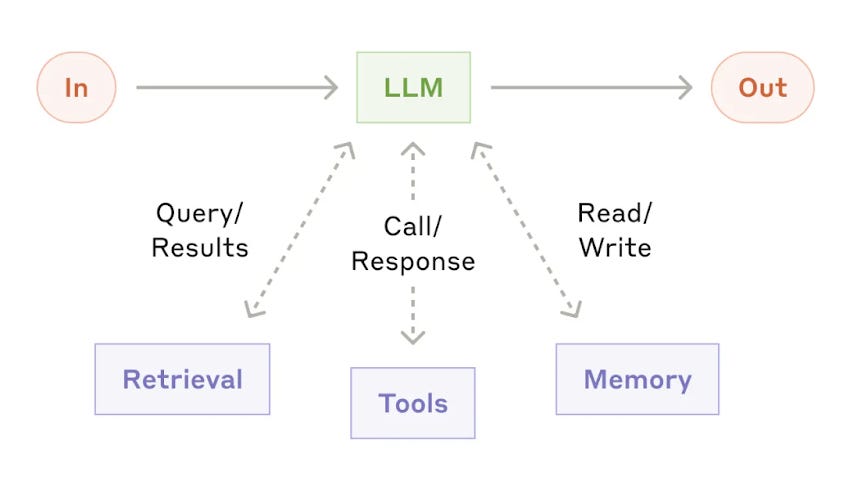Infinite Tool Use
An LLM should never output anything but tool calls and their arguments.
The tools hold the specific, instantiated state of what the model is doing and its goals, while the model itself holds only the information it requires for its immediate task and some additional context, leading to specialization between the LLM and its tools.
Exclusively working through tools allows models to externalize large parts of their intelligence to more efficient, domain-specific programs.
Table of contents:
Examples
The benefits of infinite tool use are best understood via examples.
Text Editing
Here’s how I wrote this article so far: I had an idea and wrote it down in a few bullet points. Then, I wrote the introduction. While doing that, I jumped to the end of the article, added a few more bullet points, and edited others. I started writing this section, interrupted it by writing down an idea about the architecture of such models, then came back here; realized that I should re-write this section, started doing that, edited the introduction to fit, went back to the re-write, and here we are. I’m not even half-way done with the article and I’m sure I already forgot several steps that I took.
Now contrast that with the way an LLM currently writes: It generates text forward-only. (Almost) no matter how good it is, it will make mistakes, especially in out-of-distribution (OOD) domains.
Forward-only generation makes multi-resolution generation much more difficult: I as a human can create hundreds of versions of the same article; edit a sentence here and there, write down an idea as a bulletpoint, delete something dumb, turn a bulletpoint into a full section, etc.; in other words, I can interleave actions at different levels of specificity. Imagine how confusing it would be to hold all those edits in memory at once!
Editing through external tools allows for explicit, selective forgetting. LLMs on the other hand either need to generate from most general to most specific in order—a very limiting way of multi-scale generation compared to tool-use—or generate a confusing mess of edits and re-edits and deletions that aren’t true deletions; or re-generate the entire output for every single edit; or just generate the final version all at once.
And while we can train an LLM to backtrack and correct mistakes in the form of reasoning RL, the mistakes themselves are baked into its output, and thus into both its own context window and the user answer. The latter is a problem because it makes it hard to produce long, correct outputs, the former because it is confusing to the model itself, at least if the output gets very long.
Additionally, the Chain of Thought (CoT) of reasoners doesn’t address the problem of mistakes in the final answer, even if the CoT contains all the information necessary to produce a great final output, simply because no model is ideal, and sampling errors still happen. Of course, we can interleave CoT and user-output; but then we still commit to part of the final output early.
To be clear, reasoner RL is a great thing which is highly compatible with and even required for infinite tool use and will go a long way on its own, and the failings described above are minor ones, but I nevertheless believe that infinite tool use can improve the framework significantly. In a sense, it’s the logical conclusion of what a lot of companies are currently working towards.
More generally, extremely long contexts are difficult to manage for LLMs, but might be required for very complex tasks.
Methods like Entropix try to work around these issues by dynamically adapting token-sampling parameters like temperature, by branching and merging on demand, and even backtracking, all based on an external measurement of the model’s entropy. Good sampling strategies will be valuable no matter what, but leaving the editing decisions to the model itself is likely a more scalable approach, as demonstrated to a degree by current reasoners.
The final (and correct) step of this evolution is to simply allow the model to continually improve the final answer before dumping it on the user. Give it access to a full text-editor that is controllable through special text-commands, and see many benefits:
- Multi-abstraction-scale text generation
- Effortlessly interleaving those abstraction levels
- Backtracking via editing
And the potential issue of going off-course is solved by simply refreshing the model’s memory about fine-grained details (specific sections, sentences, words, what the goal of the whole process is, …) through tool-use.
To be clear, this wouldn’t prevent the model from generating easy answers in forward-only mode. If the LLM wants to directly answer a user without going through an editing process, they can do the equivalent of typing out a quick response and immediately clicking “send” within the tool.
3D Generation
3D generation, and the other examples listed below, face the same issues in normal LLMs, and can expect the same benefits from tool use, as pure text generation.
So what would a similar tool look like for 3D generation? CAD libraries exist for Python, and I do believe that there are programming languages for several Game Engines. Therefore, an LLM could create 3D objects through code. To do so, the model should have these tools available to it:
- A way to look at the generated object, given tools to:
- Zoom in and out
- Rotate the object
- Shift the object
- And, obviously, look at the resulting 2D projection of the 3D object
- A way to think about the object
- This could just be another text-file as discussed in the Text editing section for taking notes
- The model’s context window itself (most thoughts should not be persistent, and the ones that should be can be written down in the note-taking-file)
- A way to edit and run the code itself
- In other words, another file in a text-editor (or multiple files)
This would bring the following advantages:
- Generation of arbitrary-sized objects is possible.
- This is currently not possible with text-to-3D models because in 3D-space, context windows explode when generating voxels etc.
- But with a CAD-library—or numpy, as OpenAI’s o3 is apparently doing—and the aforementioned tools, gradual generation of the object over many cycles of improvement becomes possible; in other words, human workflows are enabled
- All the advantages of the text-editing tool discussed above are available to the model
Video Understanding
A full-attention LLM is un-usable for days-long videos because it’s way too inefficient. A pure SSM is un-usable for the task because it cannot attend to enough of the video. But any LLM with a finite context window but with tools (and training to use them) can re-watch whatever part of the video it needs to understand what it has to, write down, edit, and revisit running notes, and more, without exploding costs. This makes it the obvious choice.
AI Safety
Seeing the full editing process (with version control, potentially available to the LLM as well) is bound to be fascinating. More importantly, it has safety advantages.
This can be seen by analogy to current reasoners (which are complementary to the infinite tool use paradigm, but also a proto-version of it): If the task is hard, the model must make maximum use of the tools at its diposal, which include the CoT. Since deception adds additional complexity to the CoT, it further complicates the model’s work, so if its capabilities are saturated, it will communicate as clearly as possible to itself within the CoT.
The same is true for LLMs with infinite tool use: when trained on sufficiently difficult tasks, they must use the tools at their disposal with clarity and good structure. Therefore, training them on sufficiently difficult tasks with infinite tool use will likely make their outputs more faithful and more legible.
Thoughts on Training
The main method of training an LLM with infinite tool use is through reinfocement learning. One difficulty in this might be the question of how to train over infinite (or at least unbounded) context length.
However, using LLMs with a limited context window and interacting only through tools means that there is likely no need to actively train for infinite context length, if we train to recover from mistakes & edit from many different starting points. LLMs with limited context window (SSMs, sliding window attention, …) being forgetful means that just training fairly long context windows from diverse start and end points will probably generalize to infinite context windows. However, this is one of the biggest questionmarks in this very speculative proposal.
Thoughts on Architecture
For architecture, I’m open to all possibilities; RWKV, Mamba, xLSTM, Titans, Test-Time-Training, simple attention with a sliding window, whatever.
I’m also open to using hybrids. One version that might make sense for infinite tool use is the inverse or normal hybrids (though I’m also open to those). Normal hybrids typically use a few SSM layers followed by a full (causal) Attention layer (often without positional information). For infinite tool use, it might make more sense to reverse that: several layers of sliding window attention for a high-precision but localized view of the sequence, followed by an SSM layer that provides a much more abstracted but longer range view of the input. But that’s just fun speculation, nothing I’m remotely sure about.
The main point of this section is to stress the importance of a constant inference budget per token independent of context window size (or at least one that is limited as in sliding window attention), and the usefulness of forgettfulness combined with tools.
A constant or upper-bounded per-step inference budget is obviously important for infinite tool use.
Forgetfulness—which goes hand in hand with a constant/upper-bounded per-step budget— is important because it allows for specialization between the model and its tools. Saving a billion tokens in a text file is significantly cheaper than a billion token full-attention context window.
Conclusion
The tool-use paradigm is in full swing already—o3 by OpenAI, agentic RAG models by Pleias, etc.—but still limited to very short contexts, and to only parts of the model output. I propose performing all interaction with the external world, be that users, a computer, or another LLM, through tool-use, and to scale that tool-use to ever-longer contexts using models that trade imperfect recall of the entire sequence (sliding window attention, SSMs, …) for constant (or upper-limited) per-step cost.
Acknowledgements
Thanks to stochasm for proof-reading the article and for fruitful discussions.
Citation
@misc{snimu2025infinitetooluse,
title={Infinite Tool Use},
author={Sebastian Nicolas Müller},
year={2025},
month={04},
url={https://snimu.github.io/2025/05/23/infinite-tool-use.html}
}
What's Your Reaction?
 Like
0
Like
0
 Dislike
0
Dislike
0
 Love
0
Love
0
 Funny
0
Funny
0
 Angry
0
Angry
0
 Sad
0
Sad
0
 Wow
0
Wow
0












































